Our lopsided skin-on-frame vessel yawed and flexed and the lashings creaked as the swells rolled up astern. The following sea propelled us forward while I wrestled with the rough, axe-hewn steering oar to prevent broaching and a potential capsize. The driftwood mast strained against paracord rigging as the wind billowed the slapdash tarp sail. The sky was clear. The winds were strong, but in our favor. We reached across several miles of open water, aiming to skirt the next closest island. A lobsterman turned his boat away from checking traps, crossing over to run alongside.
“Are you OK?” he asked. “Do you know where you’re going? Winds and seas are supposed to build over the day,”
“We are fine,” we told him.
“Are you boys flying a f—ing bedsheet?” he said.
We weren’t, but I liked the idea. “Yes, we are flying a bedsheet,” I replied.
My cousin Ross and I have a long history of planning and occasionally embarking on harebrained adventures. We have traveled and sailed all over the world and have discussed many voyages that we have yet to, and may never, embark upon. This particular adventure, however, started off as a question, a question about what to pack in an emergency ditch bag for a sailing voyage. Many cruising boaters pack a ditch bag and stow it where it’s easy to grab if everything has gone wrong and they have to abandon ship as the vessel begins to sink out from underneath them. The survival equipment in the bag is meant to keep them alive until they can be rescued. The question we contemplated was, if we were to find ourselves stranded on an island with a ditch bag that was equipped with minimal tools, would it be possible for us to build a small craft to navigate to the safety of an inhabited shore? We wanted to find out.
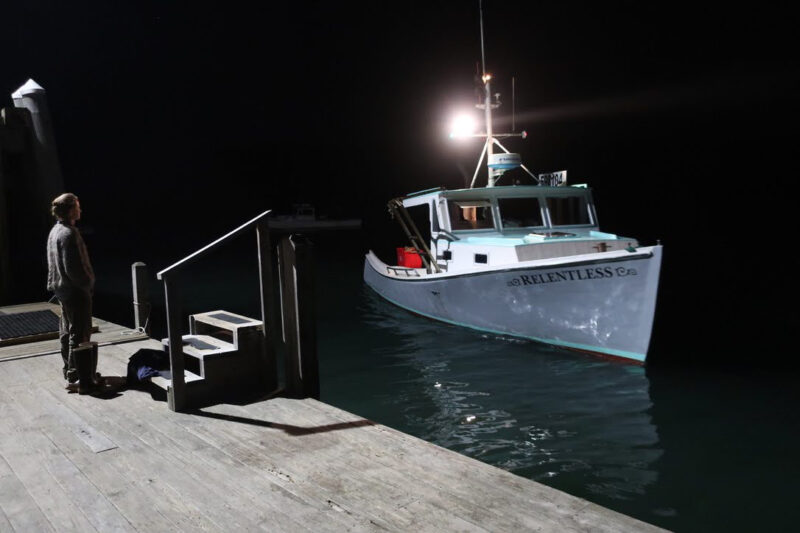 Ross Beane
Ross BeaneOur friend Kipp waited on the dock at Isle au Haut as Derrick arrived in his lobsterboat. Ross and I prepared to load our gear aboard for the nighttime voyage to the island where we would be stranded.
For years we worked on a plan. Where would we maroon ourselves? What equipment should we bring? How authentic should the experience be? The plan easily could have been filed away with countless other bad ideas and eventually forgotten, but it sounded like too much fun. Over the winter of 2019, we began planning for real.
Given the time constraints imposed by our usual obligations, we decided that the most feasible type of boat to build during our marooning would be a skin-on-frame vessel. Traditional Arctic kayaks and umiaks were skinned with animal hides, but hunting to get skins wasn’t on the table for a variety of reasons and this led to the first of many concessions to our plan. Ballistic nylon coated with two-part polyurethane is a common covering for contemporary skin-on-frame kayaks in the Greenland and Alaskan style, so we ordered enough of those materials to wrap an 18’ open boat.
 Ross Beane
Ross BeaneAfter we felled a straight birch, I used a wooden wedge and an axe to split out the gunwale pieces.
Our plan got a boost in an email from Kipp, one of Ross’s college friends who had become a Downeast Maine fisherwoman. She had caught wind of the plan and made an offer that eliminated the last major hurdles and added an element of authenticity we could never have accomplished on our own: Kipp knew of a suitable uninhabited private island that the owners would allow us to use. She and a lobsterman friend of hers, Derrick, could take us to the island at night to keep us from knowing the exact location and geography of the island.
We picked a date in mid-summer to make our “shipwreck” as pleasant as possible. The plan was to start our adventure by bailing out over the side of our delivery vessel and swimming to shore, each towing a drybag that would be our ditch bag. Since this was all for fun, mid-summer water temps would avoid making the swim a potentially life-threatening endeavor.
Ross and I waited, planned, ordered supplies, and went over our gear list during animated phone calls. Then, as often happens, our responsibilities got in the way and pushed back our schedule—first to early September, then to late September, and finally, due to a tropical storm, October. Because of the change in season, we modified the challenge and packed cold-weather gear and tents that weren’t practical or realistic to keep in a sailboat’s ditch bag. We decided that the goal was to build the boat—not to be rescued while being stupid. Days before the scheduled drop, a local lobsterman who fished off the undisclosed island told Kipp about a shark, perhaps a great white, that had been aggressively chasing traps as he hauled them. Kipp and Derrick were not willing to drop us into the ocean in Maine in October at night in shark-inhabited waters before steaming off into the dark, so there would be no swimming start. Ross and I agreed it was a reasonable modification of our plan.
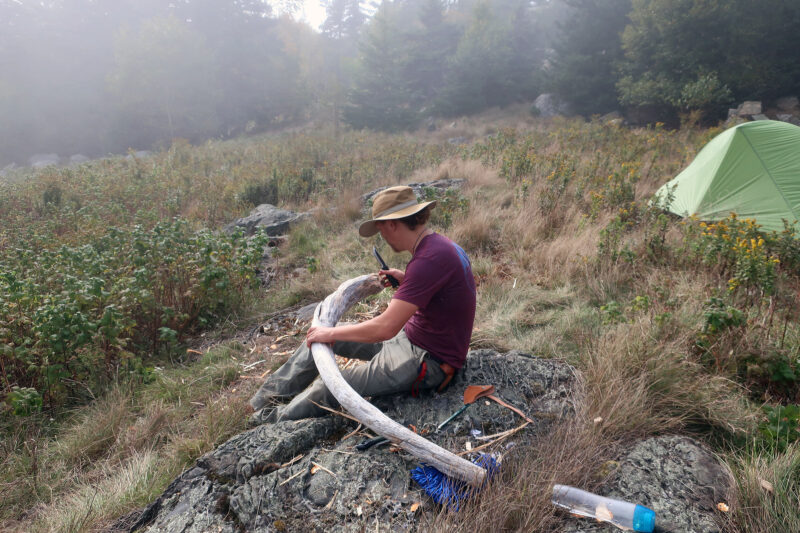 Ross Beane
Ross BeaneSitting near our campsite, I began cutting and shaping the stem from a curved piece of driftwood.
The day we began, we rendezvoused with Derrick at a commercial pier in Stonington where he kept his 41′ open-sterned lobsterboat. After we stacked our gear on the deck and got aboard, he cast off and eased the vessel away from the dock. He steered out through a few moored boats, and then throttled up. After we wound through the serpentine channels and out into bigger stretches of ocean, the open water started to look a little wide for whatever rough-hewn boat we were planning to build. We stopped on Isle au Haut long enough for a dinner with Kipp and to pick up a small flat-bottomed skiff that would take us ashore to the island without having to swim.
As we motored off into the night, Ross and I both studiously averted our eyes from the glowing chart plotter. For a while, the harsh glow of nav equipment was the only break in the darkness of the ocean at night. After a time, the soot-black silhouette of the mystery island gradually emerged from the surrounding darkness. As we rounded a headland, the engine wound down to a sputtering idle as Derrick angled in toward a small, well-protected bay. I was relieved not to be going over the side into 50-degree water for a swim to shore.
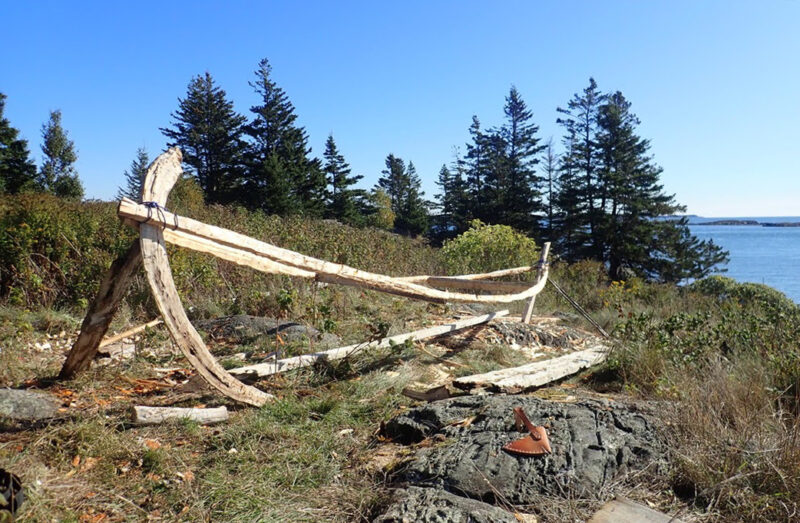 Ross Beane
Ross BeaneWe propped up the beginnings of our boat frame so that we could visualize the next steps of construction.
After a quick ride in the skiff, Ross and I scrambled over the bow onto seaweed-slippery rocks and unloaded our gear on the cobble beach. The departing lobsterboat swept its spotlight back and forth searching for shoals until it rounded the headland. Its engine revved up as it hit open water. Then there was only the dark and the sounds of the ocean—small waves gently lapping at the beach in our protected cove, and the distant thunder of swell pounding a far-off rocky shoreline.
Packed in our pile of drybags we had food and shelter as well as basic hand tools, nylon fabric for a boat skin, and artificial sinew (also nylon) for lashing. We had only a vague idea of our location. We were in Maine’s Penobscot or Jericho Bay region and knew that the island was much too far out to swim to the mainland. Until we could figure out how to build a boat, we had none for the voyage home.
After shuttling our gear by moonlight the short way to the head of the beach, we dug into our bags to find headlamps. Seeing the place for the first time by their narrow beams, we took stock of our surroundings, both of us grinning and excited to kick off this adventure. Quickly scouting for a camp, we discovered that just beyond the head of the beach there was a brackish marsh. To the south was thick underbrush, but off to the north the headland was covered with grass and scattered raspberry bushes. We decided it was a suitable spot for the night, and set up the tents, planning to seek out a better camp the next day.
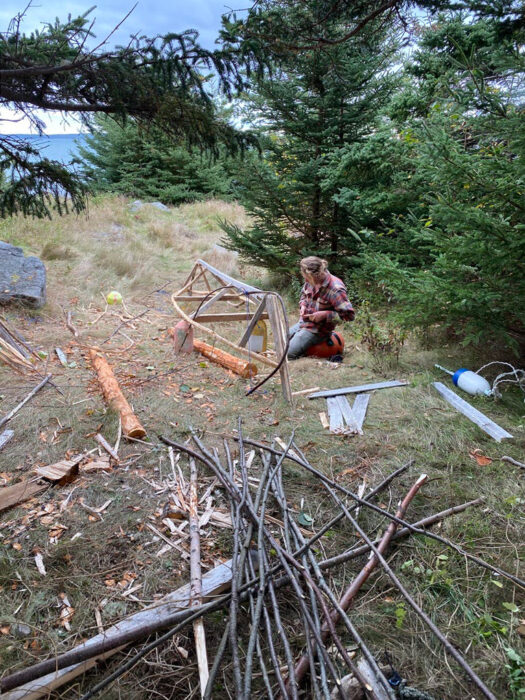 Ross Beane
Ross BeaneIn the comfort of the Boatshop, protected from sun and wind, I lashed in a fire-bent rib.
In the morning the island was blanketed in thick fog—a familiar weather pattern in Downeast Maine. Our tents turned out to be in a great location, so we remained camped there. After a breakfast of tea and instant oatmeal, we set out to take stock of our surroundings and see what useful materials we could find. Walking the perimeter of the island quickly revealed that, like most islands in the area, it had no shortage of washed-up lobster gear and driftwood. Amongst the flotsam, Ross spotted an old canoe paddle, its varnish baked off by the sun, but otherwise in good shape. Farther along, we came upon two washed-up boats: a canoe and a small rowing dinghy. The dinghy was heavily damaged, but the canoe, while broken, could have been repaired in a pinch. If we were truly trying to self-rescue, fixing the broken canoe would’ve been the best option. This wasn’t the adventure that we had come for, however, so we passed it by.
Partway through our exploration of the shoreline, the unmistakable sound of an approaching low-flying helicopter thumped through the thick fog. It whirled into sight, cutting past the island on a course farther out to sea. Its color and markings unmistakably identified it as a Coast Guard aircraft. We kept walking, but within a few minutes heard the helo circling back. Once again, they passed us flying low, but this time the crewman sitting in the open door raised a hand in a casual wave. We waved back, trying to look casual, too. Still, this encounter worried us, and we jogged back to camp to check on our emergency beacon to make sure it wasn’t somehow accidentally transmitting. It was not, but I powered up our handheld VHF radio to listen in on the Coast Guard pan-pan call. They were checking on a reported sighting of a red parachute flare. We hadn’t seen the flare because of the fog and had no idea where we were or our proximity to the flare sighting. At least we knew they weren’t looking for us, but it served as a reminder that these could be dangerous waters even for capable craft.
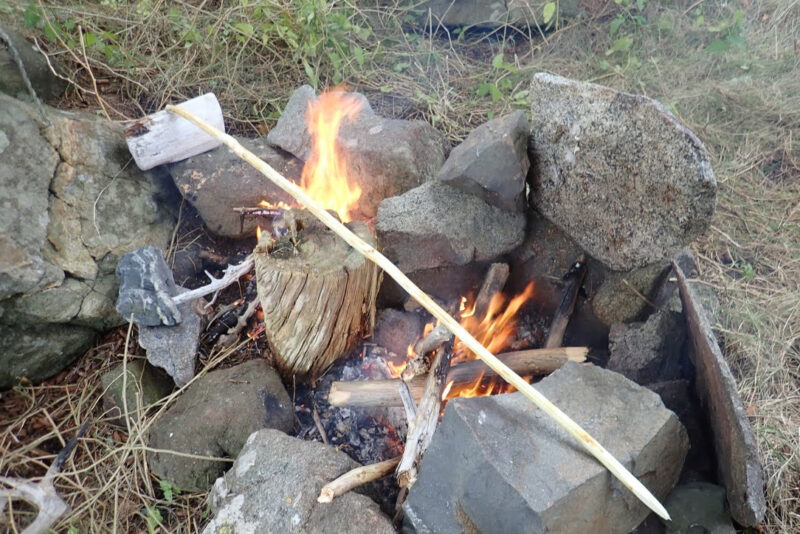 Ross Beane
Ross BeaneWe heated sapling rib-stock over two fires built roughly the boat’s bilge-width apart to put a bend in each side of a center section that would be flatter, providing better stability in the finished boat. While this rib has had its bark stripped, keeping the bark on the saplings was a more reliable technique for bending them without fractures.
After walking the perimeter, we walked two transects of the island to get a feel for the species of trees available, finding almost exclusively spruce and birch. Then, over a lunch of cheese and peanut butter on tortillas and more tea, we discussed a plan for the construction of our boat. I sketched in our logbook a rough drawing of the framework that I was envisioning for the boat and then we set off into the interior of the island to harvest a large sapling for the gunwales.
A few minutes’ walk from our camp we found a straight birch among a stand. Low swings of our axe made short work of severing the trunk close to the ground, preserving as much usable wood as possible. To split the log along the grain into two pieces, we fashioned a pair of wooden wedges. We sharpened them to a flat point with oblique swings to the end of a log, then cut the wedge off at a good working length with a folding saw. Splitting the birch took some time and sweat. While starting one of the wedges, I accidentally struck my hand with the butt of the axe head. The blow didn’t break my knuckle, but it drew blood and caused my hand to swell up. The mishap reminded us that we were indeed stranded and while we had the technology to call for help, it was best to slow down to avoid additional injuries.
We spent most of the rest of the day splitting out pieces for the gunwales and further shaping them with our camp saws and axe. Once shaped, we lashed their ends together and bowed out their middles with a temporary spreader rough-hewn from driftwood.
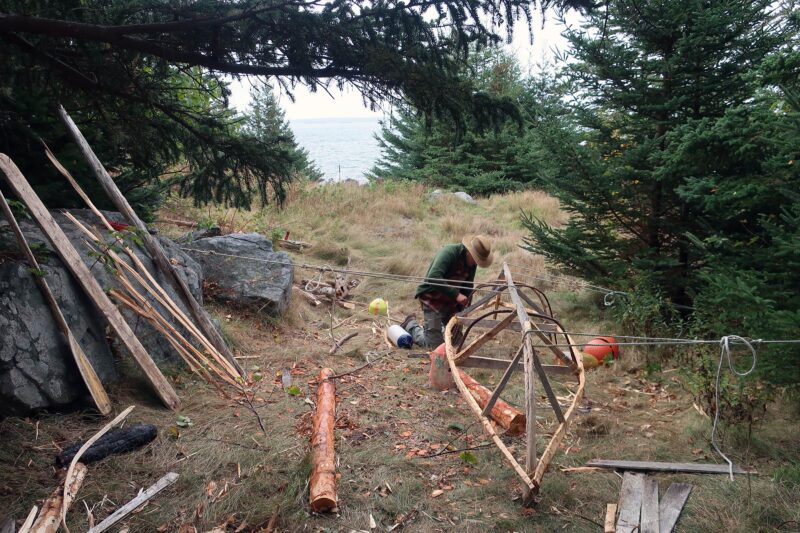 Ros Beane
Ros BeaneWe trued the boat frame by lashing scavenged nylon three-strand line to nearby trees. The L.L. Bean beavertail canoe paddle Ross found on our first day is leaned up against the boulder on the left amongst other pieces of driftwood from which we carved a second paddle.
With the remaining daylight, we scavenged the rocky shoreline for useful driftwood for the stems and keel, but a sudden rainfall sent us back to camp. Before calling it a night we hastily prepared a meal of beans and rice in the partial shelter of a broad pine tree.
The next day was clear and sunny, giving us our first views of surrounding islands and coastline. Both Ross and I had spent time working on the water on the coast of Maine, so we found our bearings pretty quickly. We still could not identify the island Kipp had stranded us on, but the direction to sail to reach the mainland was clear enough.
After breakfast, we began shaping the keel and stems. A split driftwood plank 12′ to 14′ long, likely washed away from an old dock, became the keel piece. We hewed the stem from a driftwood trunk of a tree that had grown curved out of a hillside.
The clear skies that day came with their own challenges: with the sun beating down on us, we were overheating and getting sunburned. We scouted to find some shade and found a narrow grassy gully close to our camp. It was an old overgrown camping site with the remains of a fire pit; spruce trees growing on either side provided shade and windbreak. We moved our boat frame and tools, and named the gully the Boatshop.
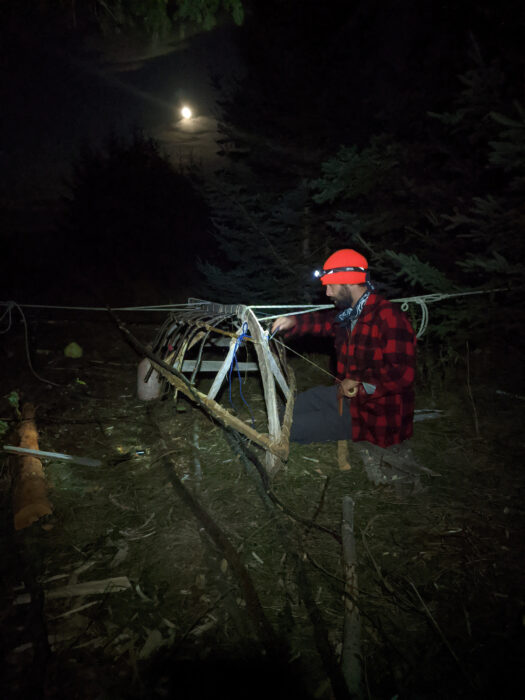 Tyler Sauter
Tyler SauterRoss worked by headlamp late into the night to complete the rib bending and lashing.
In the cooler comfort of this new location, we finished lashing the keel-and-stem assembly to the gunwales and thwarts. Triangular braces, added at the two thwarts from each gunwale down to the keel, helped keep the frame somewhat rigid and solidified the structure and it began to resemble the bones of an actual boat. The next step was to bend in the ribs. This was one of the stages of the process that I was most unsure about. In a real boatshop, with nicely milled and still-green ash or white-oak ribs and a steambox, this is a straightforward process. But on an island with none of those things available, it was a different matter. As an experiment, I tried splitting rib stock from a length of birch log. This approach didn’t achieve consistent results with the tools we had. We discussed a few other options but were running out of daylight and decided to tackle this stage of the project the next day with fresh eyes.
In the morning, after testing a few techniques, fire-bending the birch saplings proved to be the most effective means of bending the ribs with the resources available. We built two campfires side by side, approximately the boat’s bilge width apart, and fashioned a rack system out of stones to hold the saplings over the fires. Once the saplings were heated through, they bent easily by hand into approximately the right shape. Lengths of cord tied to the ends, in the manner of a bowstring, held the ribs’ shapes while they cooled. We had roughly a 50 percent success rate with this technique, losing the rest to breakage. Because the saplings were full rounds with bark still on and tapered, they tended to bend unevenly. We had to tune most of the ribs after they had cooled. We did this by whittling away wood from the inside of each rib until the turns at the bilge matched as close as possible side to side.
 Tyler Sauter
Tyler SauterRoss lashed the chine rails on with nylon artificial sinew. The blade of our axe-carved paddle is visible just above the axe, at left.
Once the tuning process was complete, the ribs were lashed into the boat—first to the keel and then to the gunwales. Each rib was sighted from the end of the framework as it was installed and flexed to fair the hull as much as possible. As we started bending in ribs, we realized that the keel of our boat wasn’t true. Being made of driftwood, it was not entirely straight in the first place, but the unequal stiffness between the two gunwales had swept its middle to starboard. To straighten it, we tied lengths of scavenged three-strand lobster-trap line between three points on the keel to nearby trees. Tensioning the lines with trucker’s hitches successfully trued up the vessel but created three thigh-high obstacles in our “shop.” We worked hard throughout the day and continued bending and lashing ribs late into the night, working by light from our headlamps and campfire.
We woke the next day excited with the progress we had made. Our vessel’s framework was close to completion. It only needed the four chine stringers lashed to the ribs to complete it. While we could easily complete that task in a day, if we worked quickly and efficiently, we could also stretch and stitch the nylon skin to the frame and perhaps even coat it with polyurethane. We could possibly set sail the following day. Being this close to completing construction in four days was substantially faster than we had imagined we could build a boat under the conditions we had chosen. We had told everyone it would take a week to 10 days. We had provisioned for two weeks and had discussed food rationing options to stretch for longer, but now a completed boat was only a day or two away.
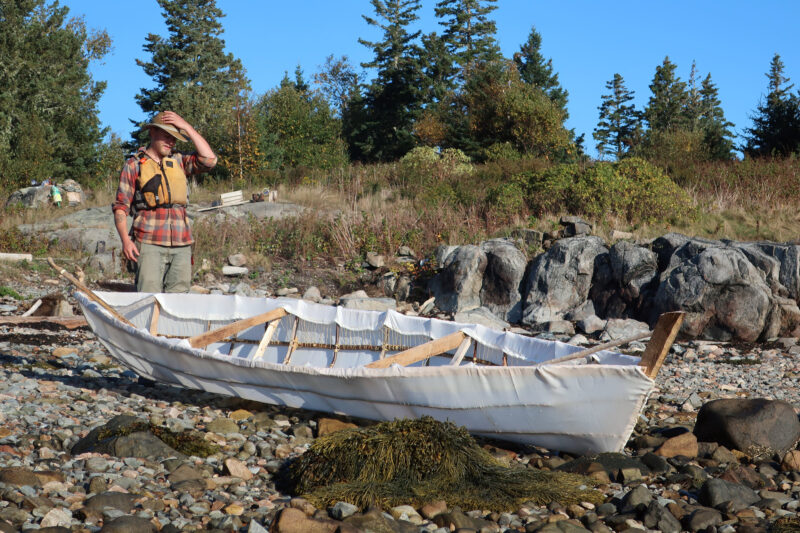 Ross Beane
Ross BeaneThe morning after we finished the canoe, I prepared to launch it for a test paddle.
We decided to break our self-imposed ban on using technology to check the weather forecast. Our goal from the outset was to test our boatbuilding skills in wilderness conditions, not to blindly face whatever weather might be coming in our small roughly built canoe. The forecast showed bad weather on the way in two days. We decided to go for it and worked hard for the day and finished lashing the frame, stretched the nylon skin, and, as the sun was setting, finally treated it to be watertight.
After the sun rose the next day, we ate a quick breakfast and then launched our makeshift vessel. A quick paddle to test seaworthiness revealed it to be somewhat tippy but quick. We hoped it would sit lower in the water and gain stability once all our gear was loaded aboard. Lashed-in floorboards, paracord standing rigging, and pieces of driftwood suitable as mast and maststep completed the final touches to the boat. With our camp broken down and gear stowed, we bent on a lightweight camping tarp as the mainsail. After double-checking our camp and boatshop, we pushed off from the beach.
The canoe, as we had hoped, had gained a reassuring stability. To play it safe, we paddled to the lee of the island before setting our mainsail. The gentle breeze in the lee eased us away from the safety of land. We gradually gained speed as our tarp/sail caught the stronger winds out of the shadow of our island. We began the first and longest crossing of our voyage. Pointing for the next island on our assumed course, our boat danced along before a favorable 12- to 14-knot breeze. Riding over ocean swells that felt bigger than they would in a more seaworthy craft, the canoe creaked and complained with every wave. About halfway across, a lobsterboat approached us, its skipper wanting to make sure we were safe and to ask about our choice of sail fabric.
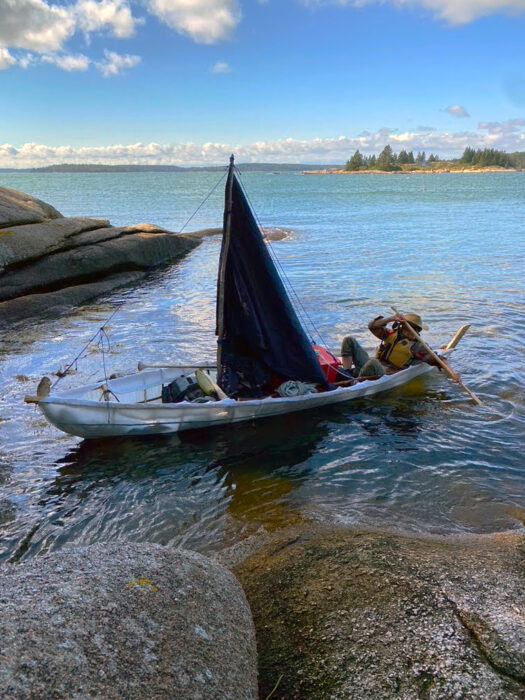 Ross Beane
Ross BeanePart way through the voyage to the mainland, we stopped on some rocks near a small island to take a rest and switch out on the helm. We had rigged the tarp as a spritsail, but ended up sailing it the whole way scandalized, without the sprit; once we were out in open water, the winds where too strong to set the full sail.
Glimpses of familiar landmarks started to peek out between islands unknown to us. The seas were steep, and the winds were strong, but so far our vessel was handling both well. We jibed across the wind, correcting our course as we began to recognize familiar islands and sailed on, propelled by the following wind and waves.
Eventually, Stonington appeared in the distance between two islands in Merchants Row that had been blocking it from our view. Stonington would be the closest option to make landfall that, while still on an island, was accessible by car. We could land there and claim success, but the sun was shining, and our vessel was sailing well. We decided to push on. I made a few sweeps of the axe-hewn steering paddle and adjusted our heading to run through the islands on the eastern side of Merchants Row. This pointed us north-northeast toward Eggemoggin Reach and the town of Brooklin and WoodenBoat School where both Ross and I had worked in the past.
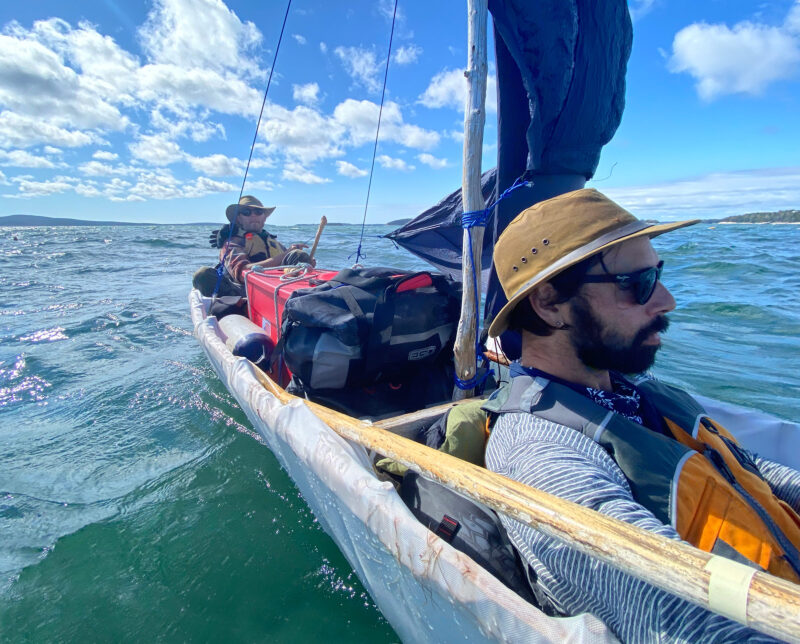 Ross Beane
Ross BeaneDuring the first half of our sail from the island, I was at the helm, steering with the rough carved paddle. Ross rode in the bow with his driftwood canoe paddle stowed but at the ready.
The day of sailing was downright pleasant and our vessel, though of rough construction, made good time. Stopping mid-afternoon on the rocks in the lee of a beautiful little island with a small, seemingly unoccupied cabin allowed us a chance to swap positions in the cramped little boat. Ross took over steering and sailed us the rest of the way. At one point we crossed a shoaling bar that stood the seas up into sharp little peaks. To have broached at this time to take a wave broadside would have certainly rolled us, but Ross’s skill as a helmsman carried us through as our vessel surfed each wave that rose up behind.
Crossing the Reach, we were questioned by another concerned lobsterman, then sailed past Hog and Piglet islands to starboard and Babson Island to port before finally dropping the tarp/sail and unstepping the driftwood mast in WoodenBoat’s mooring field. We paddled in and ran our keel aground on the boat ramp. Stepping ashore brought an end to our adventure and answered our question: If we were ever shipwrecked on some far-flung mystery island, could we build a seaworthy vessel with rudimentary tools and scavenged materials and sail to safety? Perhaps, but probably not. ![]()
Tyler Sauter is a woodworker who lives in southern Maine. He has taught sailing and has worked as a carpenter in boatbuilding, cabinetmaking, and furniture-building shops. For a time he lived aboard a 30′ sloop following work along the northeastern coast of the USA, and going on longer international voyages. Now back on land, he tries to go on as many adventures as time allows in the rivers and along the coast of New England in canoes and small sailboats.
After graduating with a degree in Outdoor Education, Ross Beane has been relentless about sharing his love of wilderness travel wherever he goes. From guiding glacier travel in Alaska to teaching sailing in Maine, he delights in spending time with people in beautiful and remote locations to foster technical know-how and an appreciation of the natural world. Ross is a perpetual student of wilderness emergency medicine, and brings an understanding of risk management that keeps it safe without compromising the fun. As an avid sailor since youth, Ross has sailed in many places worldwide, taught sailing for WoodenBoat School, and co-founded the Sailing Collective Travel Co.
If you have an interesting story to tell about your adventures with a small boat, please email us a brief outline and a few photos.
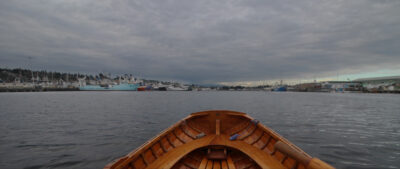

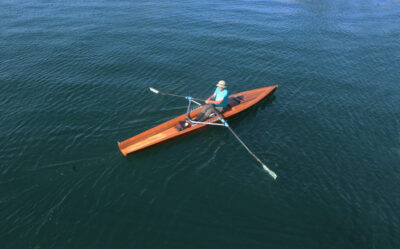
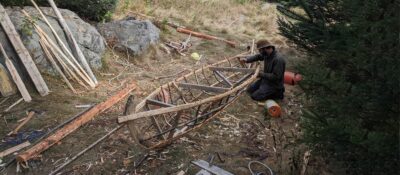
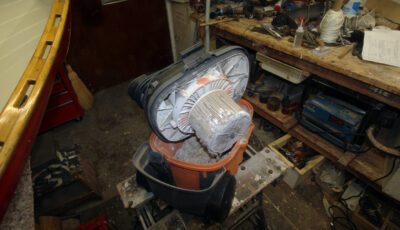
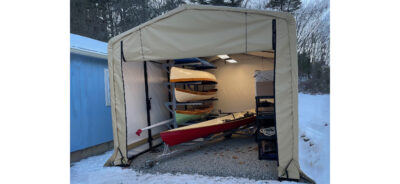
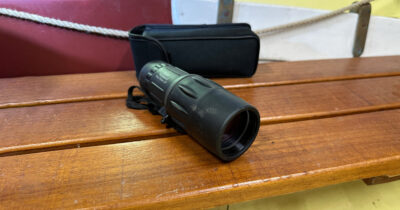
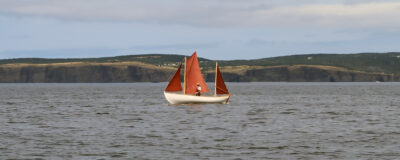
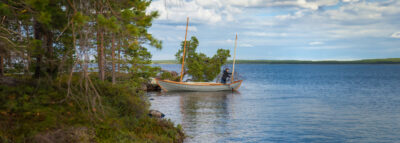
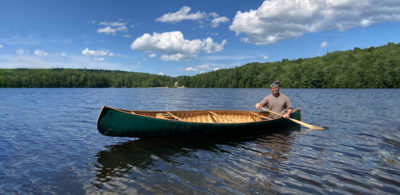
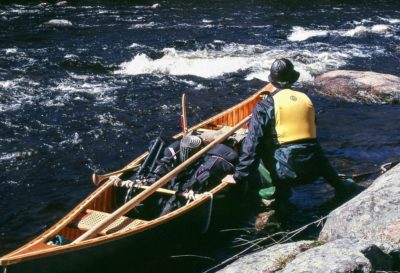
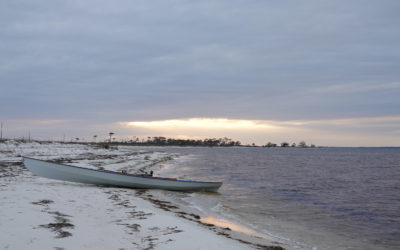
This is one of the neatest stories I’ve read here. Fantastic voyage y’all. Cheers from the West Coast.
Makes me wonder if I can do something similar out here…
This is a truly wonderful story: great idea, great follow-through. Congratulations all around.
Sam Clemens’ Huck would recognize these men, even run his raft ashore for a chat.
I’d echo Joshua’s comment, but a step further: that it’s one of the neatest stories about boats, period, that I’ve ever read. It also came across to me as one of the more authentic survival test stories that I’ve ever read, I don’t even care the ditch bag was super specific. As the text wisely mentions: It should be! And I don’t mind you didn’t swim, may as well make the test a fun adventure instead of also pushing the bounds of overcoming misery.
In terms of what was learned to teach the rest of us, I would have liked to know more specifics of prior boat building experience. In the actual text, instead of the vaguest of possible mentions in ‘about the author’ blurbs. I’m also curious how big those bags were? How easily would they stow below a companionway, could they be swam with? During the trial, what was decided was essential, and not, and what should have been brought instead?
Overall, I think this is/was a fantastic idea, a great addition to standard survival plans. Go bags should already include a knife (or three) and lots of cord. This says ‘add more cord, and a bolt of nylon.’
At end you ask: ‘if it was real could we do it? Doubt it.’ I don’t. If it’s real and your life depends on it: you can be a movie hero. As long as you don’t panic. And now you’ve got the experience and less likely to panic. And now that we’ve read this, WE are less likely to panic.
Yes. One of best boat, and even survival, stories I’ve read in a lifetime of them.
(Although, hee hee, the likelihood of landing on a island in Maine big enough to scavenge a boats worth of framing, yet without a house on it, is slimmer than shipwrecking in the first place)
“Are you boys flying a f—ing bedsheet?” he said.
We weren’t, but I liked the idea. “Yes, we are flying a bedsheet,” I replied.
LMAO
Great story, made my Saturday morning!
This is an absolutely brilliant tale, well told. Thankyou!
Well written true tale of the sea. You guys are bloody brilliant.
Cheers !
Great idea, great execution!
Congratulations on writing a super amusing story, and an inspiring one too. I happen to be an architect who likes building furniture (a close cousin to boat building?) It all comes down to joints; techniques of how components connect. And, of course, the components come out of a close and reasoned selection of materials. The boat with sail is a functional masterpiece of the ad hoc, and beautiful in its odd way. Especially the curved rigging of a keel and mast. What an object! What an adventure! Bravo, gentlemen. I’m grinning.
You guys rock!
I was intrigued by the rib bending with heat, which you used to harden the turns for more initial stability. Sounds like it paid off in spades!
Pacific Northwest Natives would slip a stick into the hollow stem of Bull(whip) Kelp and heat on the fire as a natural steam-box. Where that wasn’t available, a pile of algae (e.g., rockweeds) on a hot rock wasn’t as elegant, but would work, too. Bends were formed on a peg-jig and left to cool.
You might consider adding a “Settler’s Wrench” (a Scot’s Eye Auger modified to shape a peg-end to fit a bored hole) to your gear bag. This would provide extra-solid joints at the major intersections and save considerable cordage/lashing.
Thanks for sharing this great adventure!
Sounds like a fun experiment, in thought and practice. For real-world cruising, I wonder if an inflatable life raft or folding dinghy would use less space onboard than the tools and materials to build your own.
Fantastic idea and execution, and crazy, daring trip. I know those waters. You didn’t mention cold. I hope you sat on something insulating. Any stresses on your vessel that you noticed after you landed? Could she have carried you farther?
I hope you’ve saved her for a local museum, perhaps the Penobscot in Searsport.